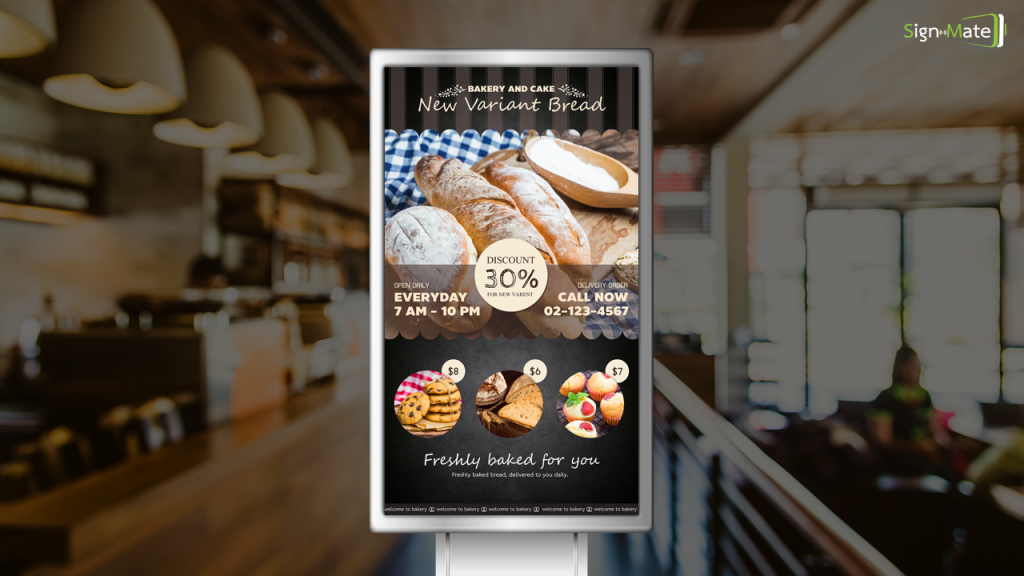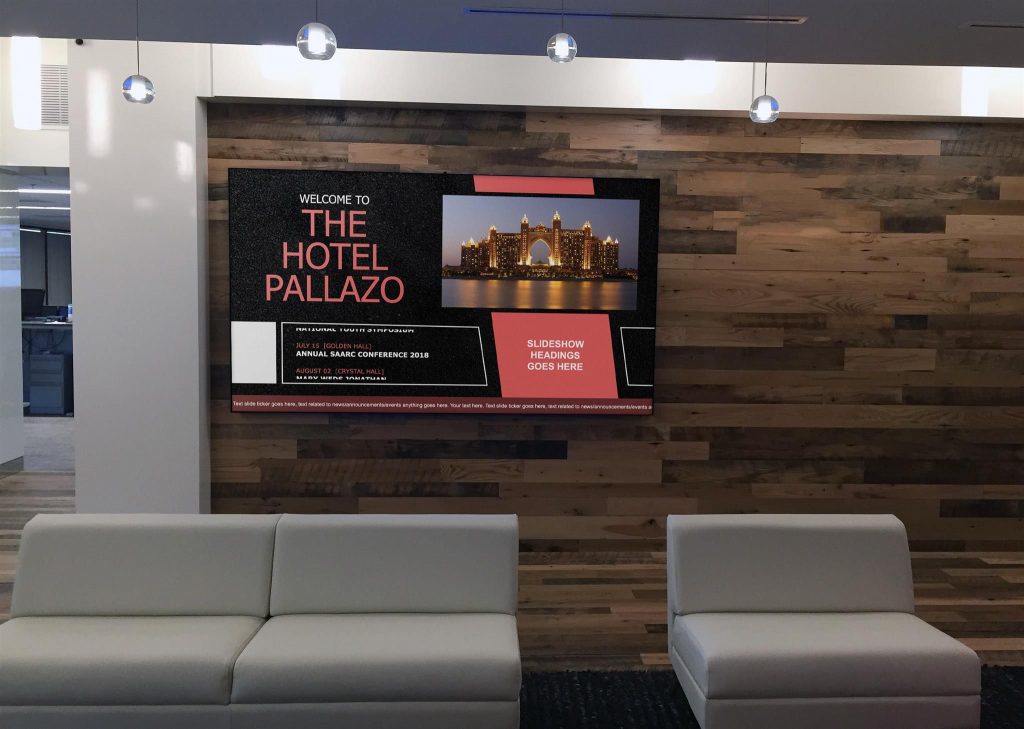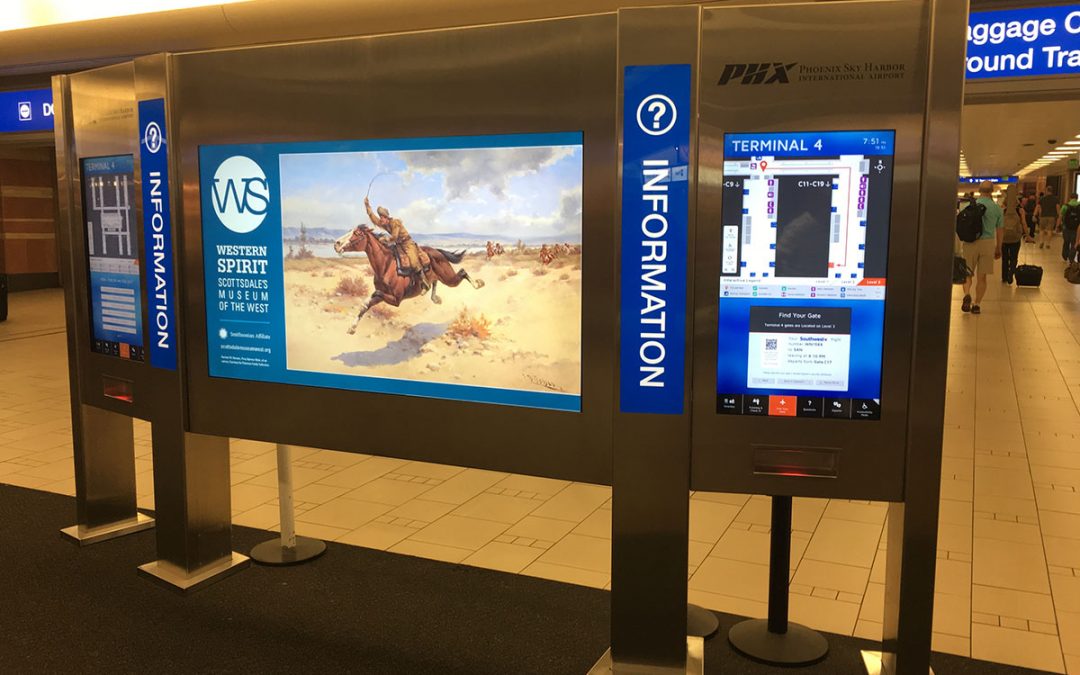Table of Contents
What is Digital Signage?
Have you walked into a McDonald’s and noticed that their menus are now on flat-screen TVs hung above the registers? This is digital signage. McDonald’s is a great example of what digital signage may look like. Different companies use digital signage in different ways and use them to solve different problems.

Digital signage and kiosks are everywhere now, especially in the fast-food industry.
For example, a bank might use digital signage for both advertising and news. It’s common for banks to have a stock ticker and weather app on a digital sign. It makes sense for a bank. That stock ticker is very timely and sensical information for its customers. That bank would also want to show its customers new products like checking accounts, CDs, or mortgages.
Medical offices might use digital signage to show patients new medical information. For instance, a dentist might want to show facts about that latest toothpaste craze. Maybe they want to remind kids to brush their teeth three times a day. In this case, the dentist’s office uses digital signage to share extra information to help make their patients healthier.

Even the DMVs have gotten a facelift with some new digital signage.
What about a DMV? Many motor vehicle departments in the United States use digital signage to show their customer queue. That has been shown to help reduce stress and anxiety for customers since they can gauge when they stand in line. Likewise, it reduces the workload on DMV workers since those signs reduce questions from customers.
How Can Digital Signage Help Your Business?
Those are a few examples of how a business might use public-facing digital signage. How would a business use digital signage for its employees? A lot of production facilities, whether that would be a manufacturer, a warehouse, or even a bakery, use digital signage to convey internal information to employees. It’s common for operations teams to share customer kudos and complaints on these digital billboards.
Likewise, they show operational metrics. Displaying this information to employees has proven to help increase productivity. Employees can see how their work directly impacts the business, so they feel more connected with it.

HR might use digital billboards to share other pieces of company information. Is there a new position opening within the company? HR can share that on these digital billboards. After all, it’s always better to hire from within the company whenever possible.
If HR does hire someone outside of the company for a new position, they can show a nice welcome message on these signs. This serves a couple of goals. First, that welcome message makes new employees feel like they are part of the team. Second, it increases company security. If your existing employees are trained to recognize new employees from these welcome messages, yet they see someone they don’t recognize, they can report that person to the appropriate people in the business.
What Difficulties May Arise When Implementing Digital Signage?
So, this digital signage thing sounds awesome, but everything comes with a catch. What are some of the issues that come with using digital signage?
Two complexities come with these types of systems. Digital signage isn’t as easy to use as an old-fashioned whiteboard or a piece of paper thumb-tacked to a wall. Those two complexities revolve around deployment and information organization.
Let’s tackle deployment first. There are essentially two phases of deployment for digital signage. The first phase involves building a system for this signage and installing the equipment to make it work. The second phase is an ongoing effort that involves constantly updating these signs.
That first phase of deployment sounds easier than it is. It might be obvious that any business will use a TV for the actual display, but some questions need to be asked when choosing these TVs. How many TVs do you need? How big do they need to be? Where are you going to place these TVs for maximum impact? How will they be powered? How will you get data to display on these TVs? Are you going to use a computer to display information on these TVs?
If so, which type is best? How will you manage the information that is sent to these TVs? Are you going to use a client-server platform? Maybe simply displaying a website will work?
Initial Deployment Phase 2
What about that second phase? After that digital signage system is in place, you need to figure out how you will update the information being displayed on these TVs. How do you organize that information? How will data be presented so people will absorb it? Employees will likely ignore these digital signs if they have no idea what they are looking at or suffer from information overload.
Managed VS DIY Solutions
Digital signage can be complicated, but it can also be easy if left in the hands of someone familiar with them. The beautiful thing about digital signage is that it can be easy enough that any business can create their solution and get that solution in front of customers and employees. Things tend to get a lot more complex when managed networks are introduced to this equation. VLANs and firewalls need to be properly configured to allow communication to these billboards.

Digital signage in hotel and resort lobbies has become extremely popular.
It can also become more complicated to manage these systems when businesses realize they need a central way (Ie. a server) to distribute that digital signage. It is a lot easier for an ops manager, an HR person, or a head chef to change the message on all signs from one PC instead of having to walk to each television to update them.
A managed services provider can also help organize the information so it can be displayed properly. The last thing a business wants to do is cause information overload for its customers and employees. It is better to pick out key pieces of information and logically display them. It’s not a good idea to throw an Excel sheet or Tableau table on a digital sign and call it a day.
To learn more about how digital signage can help your business, please give us a call at 480-493-5999 or send us a message.

